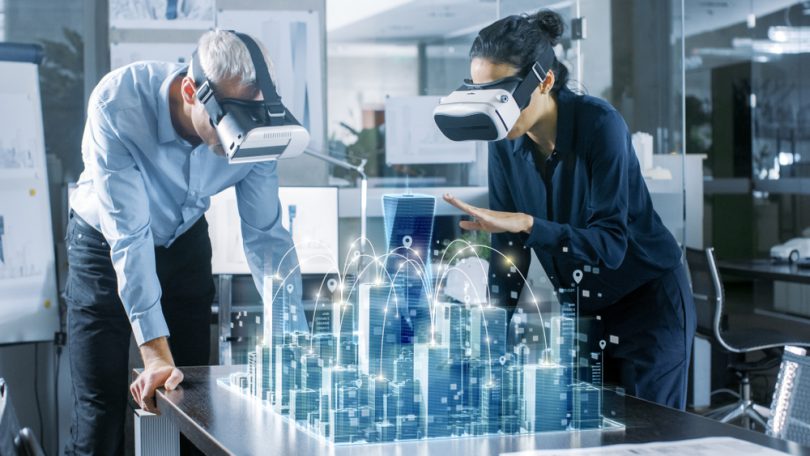By Saurabh Goenka
Any intended alteration of the built environment requires well defined goals and keen foresight to anticipate future needs. The architecture and construction industries are gaining momentum globally and the notion of a city is very different from what it used to be a few years ago. The way we approach the process of development, from analysis to design and construction, is critical to ensure smart growth in the long term. Innovation is no longer an abstract idea of that which is unconventional, rather a successful outcome of various strategies that come together to create an intelligent development.
In that regard, rapid advancement of design assistive technology has been a watershed moment in architecture. It has made the design process more efficient, interactive and ingrained with real world data, such as never imagined before. I will next, consider in detail what these technologies encompass and how they can empower the industry to build with improved visualisation, increased reliability, and accurate performance metrics.
Virtual and augmented reality
Virtual reality (VR) and augmented reality (AR) have enabled us to design and build in an immersive digital environment with instant visualisation. VR is a powerful tool that offers a life-like experience by delving into virtual models using VR headsets, which is especially valuable during design conceptualisation. Architects, consultants and clients can access the same computer-generated model simultaneously and conduct group walkthroughs. No renderings or walkthroughs can provide a comparable experiential analysis of what to expect when the project is built. Moreover, built in measurement tools help us to better assess the scale and proportion of spaces as compared to using scaled-down drawings or physical models.
Read: Carlos Bañón, Assistant Professor at SUTD, Director and Co-founder of AirLab Singapore
Typically, while designing larger projects, architects often collaborate with more than a dozen consultants due to the complex nature of work involved. We organise ‘VR Charrettes’ for the extended team every so often where designers, trade specialists and clients enter the 3D model on a software that converts models using plugins into an immersive visual experience. In this manner, any problem can be methodically assessed and collectively resolved using a single source of information. The VR experience today has been simplified to an extent that smaller models can be viewed on smartphones while on the go, using headsets like Google Cardboard. Its use as a design collaboration tool has improved communication, shortened design review periods and accelerated the decision-making process. In addition, it has also given us an enhanced sense of proportion approximation, which helps in minimising revisions and spotting critical concerns in a virtual environment before going into construction.
Like VR, AR has revolutionised our design processes by allowing an overlay of 3D models or 2D plans onto real-life environments using maps and satellite imagery. By supplying real world data to design drawings, we can better understand the topography and contextual conditions. Basic programming in design software allows for layers of information to be added in the drawings, eliciting a smarter design solution.
An environmental design software can also connect 3D models with simulation engines to predict building’s energy performance and thermal comfort. Placing the 3D model in the project’s geographical location will allow us to overlay real-world environmental data onto the building form.
An environmental design software can also connect 3D models with simulation engines to predict building’s energy performance and thermal comfort. Placing the 3D model in the project’s geographical location will allow us to overlay real-world environmental data onto the building form. Then, using an AR plugin, we can deduce which forms are more successful by virtually touring various design options.
Read: Suen Wee Kwok on innovation & institutional building design
A design is only as successful as its qualitative translation into a real building, and we have often used AR to assist in that regard as well. Using AR, 3D models can be overlaid onto construction sites to ensure accuracy and successful translation of our vision. The software can identify missing components as well as inaccurate dimensions, which enables us to detect errors earlier in the process and avoid major ramifications later.
Artificial Intelligence (AI) and Internet of Things (IoT)
Creativity is indispensable in architecture, but it is just as vital to be efficient and resourceful. Buildings are as much about aesthetics and innovation as they are about designing in compliance with performance requirements, ergonomics and/or building codes. It is the latter where AI can particularly have a remarkable positive impact. The key is to separate the known from the unknown, by streamlining repetitive processes and establishing a system of standardising recurring elements across projects. Architects often refer to past design and construction data since every completed project presents an opportunity to inform future projects. However, many offices still use traditional methodologies of record-keeping and manual referencing. In that regard, advanced data analytics and inter process communication (IPC) can come very handy.
The key is to separate the known from the unknown, by streamlining repetitive processes and establishing a system of standardising recurring elements across projects.
For instance, Building Information Modelling (BIM) can provide a single source of coordinated and computable information in a model-based framework. Sharing real-time data with the project team helps design more efficiently, allows for clash-detection, and reduces scope for miscoordination. BIM is useful throughout the building lifecycle, from design and construction to facility management and operations. It is often marketed as a production tool, but it can also work as a data-rich resource tied to a firm’s unique knowledge base.
BIM software, supplemented with the right tools can act as an architect’s own programming language. By setting the constraints and inputting programme requirements, countless iterations can be generated within minutes. This is not to say that machines can replace humans, but rather can supplement our intelligence. The value of architects in analysing a problem and finding optimal solutions remains unopposed. As an example, in designing a façade, we can use software to determine the angles of fixed louvers. By plugging in information on the façade orientation, sun angles, required privacy, desired daylighting and view corridors, we will be able to generate multiple design options with the click of a button. Tweaking the parameters can update the façade in real-time and we can select our preferred aesthetics within a few minutes. What’s more is that contractors can use the computer-generated model for fabrication and installation of the fins as well.
AI can supercharge the site analysis and construction administration process as well. Drones allow for faster surveying and inspection of project sites while also providing high resolution imagery. Related to building operations, AI based management platforms can determine energy usage patterns to conserve energy and improve thermal comfort, while also monitoring leaks or malfunctions. A smart thermostat can learn from user patterns and build a schedule accordingly. By using sensors and the phone’s location of the user, it can set itself to an eco-temperature when the user is away.
By using this comprehensive real-time data, buildings can continually adapt to their changing environments. Small yet effective AI powered devices such as smart thermostats, rain and moisture sensors or daylighting sensors not only help save energy and water, but also allow occupants to remotely control their own micro-environments.
IoT on the other hand, controls real world objects digitally and makes the living environment smarter and more responsive. Digital twin, a digital replica of the physical building, gathers data through smart sensors to better analyse a physical structure. There has been a swift progress in our ability to use this technology for energy analyses, daylight simulation and wind tunnel testing among others; all of which greatly benefit the outcome. I often use these to simulate and analyse structural deformation, solar exposure, shading, daylighting as well as pedestrian movement. By using this comprehensive real-time data, buildings can continually adapt to their changing environments. Small yet effective AI powered devices such as smart thermostats, rain and moisture sensors or daylighting sensors not only help save energy and water, but also allow occupants to remotely control their own micro-environments.
As more people adopt these technologies, AI and IoT together can help build smarter cities driven by real-time data, functioning almost like a living organism. Buildings can then communicate with each other, with the user and its surroundings to improve liveability, increase safety and protect the natural environment. Technological solutions that improve design processes are readily available, what is needed is education of clients and professionals to venture outside of their comfort zones and embrace change. While it may be foreboding that it comes at a slightly higher initial cost, this cost must be evaluated against the long-term advantages of a more efficient design process and unmatched quality of the design outcome.
About the author:

Saurabh Goenka has more than a decade of experience crafting multifaceted, award-winning projects in some of the world’s most fast-paced urban environments. He has worked on a range of scales, from designs of luxurious single-family homes to developing mixed-use residential skyscrapers and urban masterplans. As a senior associate, Saurabh is also an expert in advanced design techniques and a digital technology leader at S9 Architecture, New York. He has leveraged the power of technology not only to create aesthetically pleasing buildings but also to ensure efficient construction, operations and management processes. Saurabh is a graduate of Carnegie Mellon University, USA with a masters in urban design. He is an AIA (American Institute of Architects) licensed Architect and a LEED (Leadership in energy and environmental design) accredited professional.

 Malaysia
Malaysia Hong Kong
Hong Kong Indonesia
Indonesia Tiếng Việt
Tiếng Việt ประเทศไทย
ประเทศไทย










